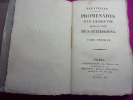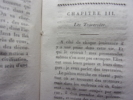354 books for « faber j l »Edit
-
Type
Book (350)
Music sheets (4)
-
Language
Dutch (1)
French (353)
-
Century
16th (3)
17th (8)
18th (3)
19th (59)
20th (137)
21st (53)
-
Countries
Belgium (24)
Denmark (32)
France (265)
Italy (1)
Switzerland (32)
-
Syndicate
CLAM (2)
ILAB (189)
NVVA (8)
SLACES (8)
SLAM (141)
Topics
- Alsace (2)
- Antarctica (2)
- Aquitaine (2)
- Archaeology (2)
- Architecture (2)
- Austria (1)
- Bank - stock exchange (1)
- Biography (3)
- Catastrophe (1)
- Catholicism (2)
- Children’s books (3)
- Christ (the) (4)
- Christianity (8)
- Churches (1)
- Clock-making (1)
- Contemporary look (1)
- Dedication (1)
- Dictionaries (1)
- Earth (1)
- Economics (2)
- Emigration (1)
- England (1)
- Esotericism (1)
- Ethic (6)
- Exhibition catalogue (2)
- Geology (4)
- Germanic languages (8)
- Germany (2)
- Greek (1)
- Gregori (1)
- Helvética (2)
- Historical general points (1)
- History (7)
- India (1)
- Industrial arts & crafts - fine arts (1)
- Italy (1)
- Jacob (1)
- Journalism (1)
- Latin (7)
- Law (3)
- Literature (75)
- Lourdes (2)
- Luther (1)
- Mariology (1)
- Mathematics (2)
- Medicine (5)
- Memories (1)
- Military arts (10)
- Napoleon i (2)
- Newspapers press (1)
- Oenology (1)
- Ornithology (2)
- Painting (1)
- Palaeontology (1)
- Paris (1)
- Pauperism (1)
- Philology (1)
- Philosophy (1)
- Photography (8)
- Poetry (1)
- Portugal (1)
- Prehistory (2)
- Psychology (1)
- Regionalism (1)
- Religions (11)
- Reptiles (1)
- Russia (5)
- Scandinavian (2)
- Scandinavian literature (2)
- Sciences (1)
- Scores (6)
- Sculpture (1)
- Shapes & colours (2)
- Songs (4)
- Spa (1)
- Sports (2)
- Switzerland (2)
- Symbolism (1)
- Tea (2)
- Theatre (3)
- Theology (18)
- Topography (2)
- Translation (2)
- Travel (2)
- United kingdom (1)
- Various (2)
- Wallonia (1)
- Waltz (1)
- War (1)
- Zurich (1)
Über stetige Funktionen. (In ""Mathematische Annalen. 66. Band. 1909""). - [FIRST PUBLICATION OF THE 'HIERARCHICAL BASIS' WITHIN MATHEMATICS]
Berlin, Julius Springer, 1909. 8vo. Bound with the original wrappers in black full cloth. A small white barcode pasted on to top left corner of front board. Library stamp pasted on the pasted down front free end-paper and stamp to verso of title page. A very nice and clean copy. [Faber:] Pp. 81-94. [Entire issue: IV, 575, (1) pp.].
First printing of Faber's important paper in which he introduces the 'hierarchical basis' and uses it for the representation of functions. Faber was building on the idea of Archimedes who computed approximately using a hierarchy of polygonal approximations of a circle. In the 1980s Faber's idea became an important ingredient for the efficient solution of partial differential equations.The issue contain the following papers of interest:Weyl, H. Singuläre Integralgleichungen. Pp. 273-324.Weyl, H & F. Jerosch. Über die Konvergenz von Reihen, die nach periodischen Funktionen fortschreiten. Pp. 67-80.And many other papers by contemporary mathematicians.
Viser og Vers. Udgivne af Villiam Faber.
Kjøbenhavn, Wroblewski, 1877. Pænt samtidigt hldrbd.med rygforgyldning. Med forfatterens portræt i træsnit. Indholdsfortegnelsen med lidt brunpletter.
Originaludgaven.
Mon livre des couleurs. La magie des couleurs. Notre vie avec les couleurs. Avoir le sens des couleurs. Le message naturel des couleurs et son utilisation.
Guy Trédaniel, Editeur, 2000, in-8 broché de 205 pages, couverture illustrée, illustrations. Bon état.
Iurisprudentiae Papinianeae scientia. Ad ordinem istitutionum imperalium reformata.
Lyon, Chouet, 1607. 4to. In contenmporary full vellum. Binding with wear, soiling and miscolouring. Back board with wormholes and corner and and head and foot of spine with loss of vellum. Title-page with light soiling and previous owner's name in contemporary hand. Small dampstain to upper margin, but internally generally nice and clean. (16), 1172, (22) pp.
Rare first edition of Favre’s commentary on Roman jurist Papinian, one of the founding jurists at the school of law at Beirut in the second century. Here Favre attempts to present and analyse all the rules of Roman laws in a scientific and systematic way.
Betænkning fra Kommissionen angaaende Foranstaltninger til Bekæmpelsen af Tuberkulosen
København, Schultz, 1902. 4to. In contemporary half calf. Light wear to extremities and a few marginal underlignings and notes on first 16 ff, otherwise fine. (32), 228 pp.
Rare first appearance of the report from the Danish Royal Commission of 18th November 1901 on how to prevent and cure tuberculosis. The commissions work had profound influence on the spread of tuberculosis and in particular the death rate which dropped dramatically. ""In 1901, a national society for the prevention of tuberculosis was stated in Denmark, which now has ten sanatoria, and the results of the very comprehensive measures adopted have been so good that Denmark has long held second place to New Zealand in having the lowest tuberculosis mortality."" (New Zealand, Parliamentary Debates, 1948).
Thesaurus Eruditionis Scholasticae: Sive Supellex instructissima vocum, verborum, aclocutionum (...) Iam post aliorum operas per Augustum Buchenerum. Novam hanc editionem (...) Christopherus Cillarius infinitis locis correxit, & innumeris accessionibu...
Lipsiae, Thomas Fritsch, 1696 Folio. Bound in two cont. full calfs with richly gilt backs and 6 raised bands on each and 3 brown titlelabels. Title in red/ black with engraved vignette, also an old owners name. A few pages with stains or brown spots, otherwise internally fine. (8),2606,(144) pp. Covers with minor scratches and a little rubbed.
Indledning til Dyrlæren. Til Brug ved den naturhistoriske Underviisning.
Kbhvn., 1815. Orig. blåt kardusomslag. 36 pp., 2 foldeplancher og 1 kobberst. planche (med frø, fugl og fuglerede).
Observations sur L'Armée Francaise des derniers Tems à partir de 1792 jusqu'en 1808.
St. Petersbourg, 1808. 8vo. Contemp. hcalf richly gilt spine with gilt monogram af Fr.VI. (4),110 pp.
Forelæsninger over Krigsbygningskunst til Brug ved Undervisningen i Officerskolens næstældste Klasse. Trykt som manuskript.
Kbhvn. 1899. Samt. lidt slidt halvlæder. (8), 289 pp. Med stempler.
Planer til Forelæsninger over Krigsbygningskunst til Brug ved Undervisningen i Officerskolens næstældste Klasse. Trykt som Manuskript.
Kbhvn. 1899. 4to. Orig. halvshirt., permer plettede. Med 228 Figurer på 32 planer. Med stempler.
Taler ved Indvielsen af Svaninge Kirke den 17 December 1837. Med indledende bemærkninger, samt en Fremstilling af Præsten Hans Madsens Daad 1535.
Odense, Hempel, 1838. Meget smukt samtidigt hldrbd., rig rygforgyldning, permer med rammer i guldtryk (i udstyr som et gaveeksemplar), helt guldsnit. Planchen af kirken mangler. XV,72 pp.
Varde Sølv. Guldsmede på Varde-Egenen og deres arbejder ca. 1600-1870.
Varde, 1983. 4to. Opapbd. 247 pp. Rigt illustr.
Unter Eskimos und Walfischfängern. Eismeerfahrten eines jungen deutschen. Zweite Auflage.
Stuttgart, Robert Lutz, (1916). Contemp. hcalf. Contemp. hcalf. Gilt spine. Gilt lettering. Stamp on title-page. Frontispiece. (14),369 pp., 1 folded map. internally clean and fine.
Bemerkungen über die französische Armee der neuesten Zeit, oder der Epoche von 1792 bis 1807.
Königsberg, Nicolavius, 1808. Contemp. hcalf. Richly giltspine. Titlelabel with gilt lettering. Light wear to top of spine. Stamp on title-page. VIII,150 pp.
Samling af Reskripter, Kammer= og Collegii=Breve m.m. som angaae Fyens Stift. 1791-92, 1794-1802.
Odense, (1791-1802). Indbundet i 11 samt. hldrbd.
B.Danica I:647. Samlingen udkom alene i årene 1791-1802.
Geologie van Nederland. I. Allgemeine Geologie. II. Historische Geologie. Derde r.
Gorinchem, 1948. Ohcloth. (6),448 pp. Richly illustr.
UN GISEMENT CAPSIEN DE FACIES SETIFIEN MEDJEZ II EL-EULMA ( ALGERIE )
PARIS CNRS 1975 1 volume in-4 broché de 448 pages , couverture glacée rempliée , très nombreux dessins , shémas , plans et reproductions photographiques , couverture légèrement défraichie , bon état intérieur . Bon Couverture souple
Phone number : 04.71.02.85.23
Oxford Apostles : Character Study of the Oxford Movement.
London Faber & Faber 1974 1 vol. broché in-8, broché, XXIII-467 pp., index. Dos ridé. Sinon bon état.
Hermathena Altorphina Hoc est, Tractatus de Alimentis Juridicus, Variâ variarum rerum Theologicarum, Juridicarum, Medicarum, Mathematicarum, Politicarum, Philologicarum discussione refertus, omnibus omnium Facultatum Studiofis usui & recreatiom fututus.
Noribergae (Nuremberg), Halbmayer, Noribergae (Nuremberg), Halbmayer1628 ; in-12, veau brun, dos orné de l’époque. 8 ff., 236 pp.ÉDITION ORIGINALE très rare de ce traité où l’auteur étudie les différents aspects des droits et devoirs en matière alimentaire. Jacob Faber était professeur de droit dans la célèbre université d’Altorf près de Nuremberg, on ne lui connaît pas d’autre livre que celui-ci. Un des poèmes liminaires nous apprend qu’il était originaire de Stetin. Les 8 feuillets liminaires portent différentes dédicaces ; un poème néo-latin d’Andrea Corvini, une dédicace en prose de l’auteur à Gaspard Schönberg, conseiller et premier secrétaire du Duc Électeur de Saxe, une dédicace en français de l’auteur à Jean Caspar de Körbitz, maître d’hôtel de l’Électeur de Saxe dans laquelle Faber explique le projet de l’ouvrage : “ce traité montre, comme selon le droit et la raison il faut donner ou bailler des alimens aux désireux & defectueux, chose à la vérité pleine de la piété & équité & propre aux généreux & illustres hommes.” Suit une dédicace de Faber à Gabriel Tuntzelio, jurisconsulte de l’Électeur de Saxe, une table des chapitres et 5 textes en prose et en vers dédiés à l’auteur par ses confrères : André Dinner, J.-G. Frauenburg, Louis Jungerman, G. Maurice, J. Tydeus.Pas dans Weiss, Gastronomia. Petit accident à un mors et à la coiffe supérieure.
# TITRE: En Russie avec Napoléon
# AUTEUR: Faber du Faur # ÉDITEUR: Quatuor, Entremont le Vieux # ANNÉE ÉDITION: 2002 # ENVOI, BEAUX PAPIERS: 150gr couché semi-mat # COUVERTURE: pleine soie noire d'orient # DÉTAILS: Gd in 4° relié 208pp. Avec sont emboîtage illustré en couleurs. 93 illustrations en couleurs. tiré à 1200 exemplaires. Etat de neuf. # PHOTOS visibles sur www.latourinfernal.com
Mémoires illustrés du major Christian Wilhelm von Faber du Faur, 1812. C'est un des très rares témoins et acteurs de la campagne de Russie à avoir la présence d'esprit de croquer sur le vif , comme le ferait un journaliste aujourd’hui, les scènes souvent tragiques de cette mémorable catastrophe. Nous reproduisons dans cette édition, le texte et les planches originales de l'édition allemande de 1831, ainsi que la très intéressante préface de l'édition française de 1895. Tous les croquis et ébauches , généralement situés sur la page de gauche, en petit et au-dessus du tire de chaque chapitre, sont les croquis réalisés sur le vif, comme des ”instantanés” et si l'on peut dire dans ”le feu de l'action”.
coeurs volcans et chrysanthèmes tallandier
Editions Tallandier 1965 1965. Doris Faber: Coeurs volcans et chrysanthèmes/ Tallandier 1965 Référence: LMA16O. Doris Faber: Coeurs volcans et chrysanthèmes/ Tallandier 1965
Bon état
Adieux à la bien aimée arc en ciel
Editions Tallandier 1982 1982. Doris Faber: Adieux à la bien-aimée/ Editions Tallandier Arc-en-Ciel 1982 . Doris Faber: Adieux à la bien-aimée/ Editions Tallandier Arc-en-Ciel 1982
Très bon état
Bagatelles / PROMENADES D'UN DESOEUVRE DANS LA VILLE DE SAINT PETERSBOURG
Bagatelles / PROMENADES D'UN DESOEUVRE DANS LA VILLE DE SAINT PETERSBOURG Théodor Von Faber complet en deux vols brochés, sous couvertures cristal, 180x110, bien frais, 250 & 193 pages( rare ) Paris, J.klostermann & Delaunay, MDCCCXII Théodor von Faber (né à Riga 1766 - mort en 1847 à Paris) était un avocat et écrivain allemand. Theodor von Faber a grandi à Magdebourg, et a étudié à l'Université de Halle, et Strasbourg. En 1789, il se rend à Paris et est entré 1792 à l'armée révolutionnaire française. Il a combattu dans la région Champagne et en Belgique, en captivité autrichienne qu'il a fui 1795. Il a été employé à Aachen dans l'administration civile française et était professeur à Cologne. En1805 professeur d'une chaire à l'Université de Vilnius, ensuite à Saint-Pétersbourg, où il a travaillé dans le service extérieur. Entre 1807 et 1812, il a vécu dans la Livonie, puis il était un fonctionnaire du ministère de la Police. En 1816, il a été nommé en 1818 membre de l'ambassade de Russie à Frankfort sur Maine et au Congrès Aachen à l'état réel. (Source: Wikipédia).
 Write to the booksellers
Write to the booksellers










